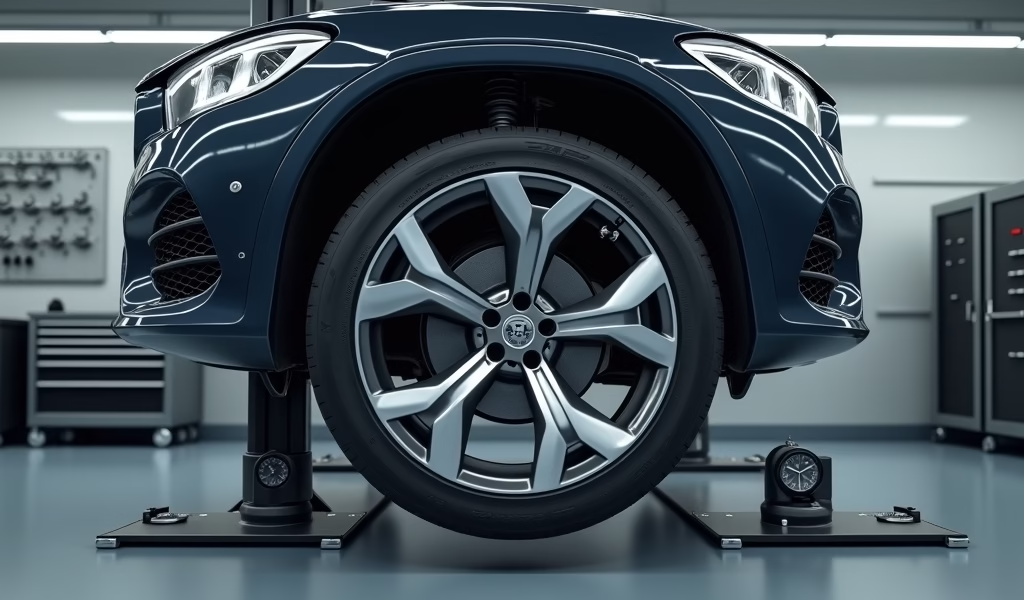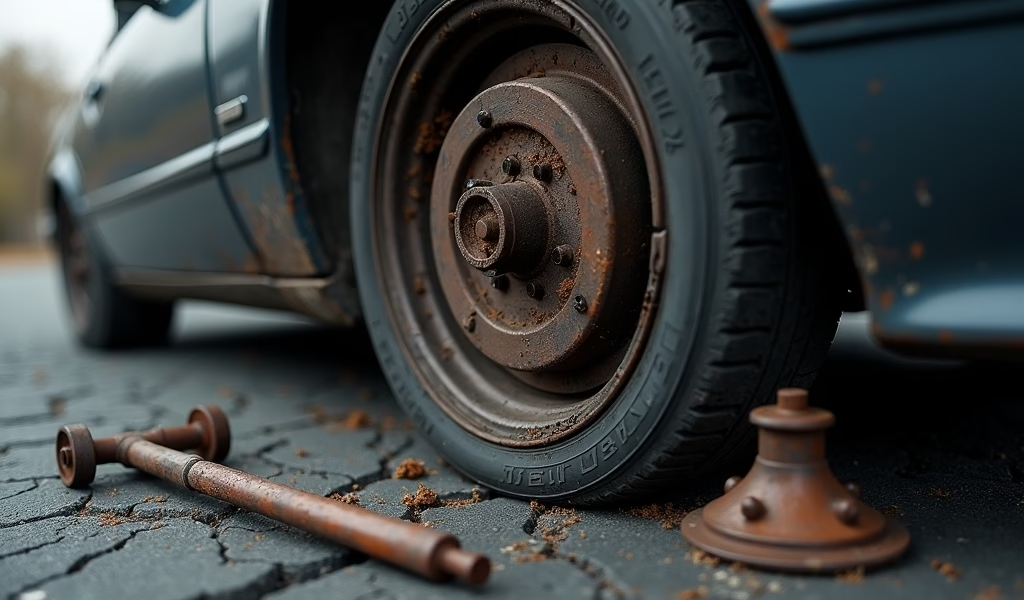Overview
This article explains scrub radius—the horizontal distance between the steering axis and tire contact patch—as a critical suspension measurement that affects vehicle handling, stability, and tire wear. The guide provides five detailed tips for calculating and optimizing scrub radius, covering proper measurement techniques, formula application, accounting for wheel/tire modifications, considering suspension height changes, and verifying calculations for different vehicle types.
Table of Contents
- Introduction
- What is Scrub Radius?
- Tip #1: Gather the Right Measurements
- Tip #2: Use the Correct Formula
- Tip #3: Account for Wheel and Tire Modifications
- Tip #4: Consider Suspension Height Changes
- Tip #5: Verify Your Calculations
- Practical Applications
- Conclusion
- Frequently Asked Questions
Introduction
Have you ever wondered why some cars feel rock-solid on the highway while others wander like they’ve had one too many drinks? The secret might be lurking in a tiny but mighty suspension measurement called scrub radius. This often-overlooked hero of vehicle geometry is the unsung champion behind your car’s handling character, steering feel, and even tire longevity.
Here at Knows Your Car, we’ve seen countless vehicles suffering from mysterious handling quirks that all traced back to improper scrub radius. It’s like the secret sauce of suspension geometry – get it right, and everything just clicks. Get it wrong, and you’re in for a bumpy (and potentially expensive) ride.
Whether you’re a weekend wrench warrior, professional technician, or just someone who wants their ride to handle like it should, understanding scrub radius calculation can transform your driving experience. Let’s pop the hood on this critical suspension measurement and uncover how to nail it for your specific vehicle!
What is Scrub Radius?

Imagine drawing an invisible line through your steering axis (that’s the line running through your upper and lower ball joints, or through your strut mount and lower ball joint) all the way down to where it meets the road. Now picture another line running straight through the center of your tire’s contact patch. The horizontal distance between these two points? That’s your scrub radius!
This seemingly tiny measurement—usually ranging from zero to a few inches—packs a serious punch in how your vehicle behaves:
- Positive scrub radius: The steering axis hits the ground inside the tire contact patch center. You’ll find this on most trucks and classic rear-wheel-drive vehicles, offering natural steering feedback but sometimes causing the dreaded “pull” during uneven braking.
- Negative scrub radius: The steering axis meets the road outside the tire contact patch. Common in front-wheel-drive cars, this design keeps things stable when one wheel hits that surprise patch of ice.
- Zero scrub radius: The perfect middle ground for many performance applications, reducing jarring steering feedback while maintaining that connected-to-the-road feeling.
As my old mentor at Knows Your Car always says, “Scrub radius is like hot sauce – a little bit enhances everything, too much ruins your day, and the right amount depends entirely on your taste!”
This critical measurement affects everything from steering effort to alignment stability and even how your vehicle responds in emergency situations. No wonder the pros obsess over getting it just right!
Tip #1: Gather the Right Measurements
Let’s be honest – calculating scrub radius isn’t something you’ll nail with a quick eyeball and some guesswork. Precision matters here, folks! Before you start crunching numbers, you’ll need to round up these essential tools:
- Digital calipers (the mechanic’s best friend)
- Sturdy straight edge
- Plumb bob (old-school but effective)
- Tape measure
- String (more useful than you’d think)
- Level (because gravity plays tricks)
Now for the critical measurements you’ll need to capture:
- Wheel offset (the distance from the mounting surface to wheel centerline)
- Steering axis inclination angle (sometimes called SAI)
- Kingpin inclination angle (particularly on vintage vehicles)
- Tire width (the actual mounted width, not just what’s printed on the sidewall)
- Wheel width (measured rim edge to rim edge)
- Hub-to-hub width (for the complete suspension picture)
For vehicles with MacPherson strut setups, you’ll need to pinpoint both the upper strut mount pivot point and the lower ball joint. If you’re working with a double-wishbone suspension (lucky you!), locate both upper and lower ball joints.
Pro tip from our shop floor: Always make these measurements with the vehicle sitting at proper ride height on a perfectly level surface. Suspension geometry transforms dramatically when compressed or extended, so catching it in its natural state is crucial!
Tip #2: Use the Correct Formula
Now for the fun part – the actual scrub radius calculation! Don’t worry, you won’t need a PhD in physics, just careful attention to detail. The basic formula looks like this:
Scrub Radius = (Kingpin Inclination × sin(Kingpin Angle)) – Wheel Offset
Let’s break down a real-world example so you can see how this actually works in your garage:
Imagine you’re working on a vehicle with:
- Kingpin inclination: 12 degrees (pretty common)
- Wheel offset: 45mm (about 1.77 inches)
First, you’ll need to convert that kingpin inclination into an actual distance measurement. If the spindle height is 14 inches, then:
- Kingpin offset = 14 × sin(12°) = 14 × 0.208 = 2.91 inches
Now calculate the scrub radius:
- Scrub radius = 2.91 inches – 1.77 inches = 1.14 inches positive scrub radius
Remember that wheel offset is typically measured in millimeters and listed on aftermarket wheels as a positive or negative number. Positive offset means the mounting surface sits toward the outside of the wheel, while negative offset pushes it toward the inside, creating that aggressive “deep dish” look some folks love.
One common mistake I see all the time is mixing metric and imperial measurements. Pick one system and stick with it throughout your calculations – your future self will thank you!
Tip #3: Account for Wheel and Tire Modifications
Let’s face it – stock wheels are rarely exciting enough for true car enthusiasts. But before you splurge on those gorgeous new rims and rubber, you should understand how they’ll affect your scrub radius. Those aftermarket goodies can dramatically alter your suspension geometry, sometimes with hair-raising consequences!
Wheel offset changes:
Every 10mm decrease in offset (going from +45 to +35, for example) increases your scrub radius by approximately 10mm (0.4 inches). This explains why some vehicles develop that heavy, wandering steering feel after wheel upgrades – the scrub radius got thrown way off!
Tire width impacts:
Wider tires shift your contact patch position. For every 20mm increase in tire width, expect roughly a 5mm change in effective scrub radius. Those meaty tires might look awesome, but they’re secretly reworking your suspension geometry.
Here’s how to calculate for modified setups:
- Find the difference between original and new wheel offset
- Factor in half the difference in tire width (since width is added equally on both sides)
- Add these values to your original scrub radius
For example, if upgrading from a 7-inch wheel with +45mm offset and 205mm tires to an 8-inch wheel with +35mm offset and 225mm tires:
- Offset change: 10mm (increases scrub radius)
- Tire width increase: 20mm (half of which, 10mm, affects scrub radius)
- Total scrub radius increase: approximately 20mm (0.8 inches)
That’s enough to transform your precision-handling sports car into a wandering mess! The engineers at SAE International have extensively documented how these seemingly small changes can have outsized effects on handling characteristics.
Tip #4: Consider Suspension Height Changes

Ah, the eternal temptation to lower (or lift) your ride! While height adjustments can transform your vehicle’s appearance, they’re also secretly messing with your scrub radius. That slammed stance isn’t just about looks – it fundamentally rewrites your suspension geometry.
Lowering effects:
Dropping your ride typically increases positive scrub radius by changing the steering axis inclination. For every inch of lowering, you might see up to 0.25 inches of scrub radius change. That might not sound like much, but it’s enough to make your car handle completely differently.
Lifting impacts:
Lifting a vehicle generally decreases scrub radius and can sometimes flip a positive value into negative territory. This explains why some lifted trucks develop that vague, disconnected steering feel that makes highway driving… interesting.
At Knows Your Car, we’ve seen countless lowered vehicles come in with mysterious handling issues and excessive inner tire wear – all stemming from overlooked scrub radius changes.
Here are some smart compensation strategies:
- When lowering, consider wheels with increased positive offset to counterbalance the geometry changes
- When lifting, wheels with decreased offset can help maintain proper scrub radius
- Adjustable ball joints or strut mounts allow fine-tuning of steering axis inclination
Remember that suspension modifications rarely affect just one alignment parameter. When you change ride height, you’ll need to reassess caster angle, camber, and toe settings alongside scrub radius. It’s all interconnected in the suspension tango!
According to the Hunter Engineering Company, one of the leading alignment system manufacturers, proper compensation for height changes is essential for maintaining both handling performance and safety.
Tip #5: Verify Your Calculations
Even the most careful calculations benefit from real-world verification. Trust, but verify – that’s the mechanic’s mantra! Here’s how to confirm your scrub radius values are actually correct:
Physical verification method:
- Position your vehicle on a perfectly level surface at proper ride height
- Place a straight edge against the plane created by the upper and lower ball joints
- Extend this line to the ground using a plumb bob (gravity never lies!)
- Measure the horizontal distance from this point to the center of the tire contact patch
This hands-on approach often reveals discrepancies between theoretical calculations and real-world geometry. Cars are complex beasts, and sometimes the math doesn’t capture everything happening in your suspension.
Watch out for these common calculation errors:
- Accidentally mixing metric and imperial measurements (a classic blunder!)
- Using rim width instead of wheel offset in your formula
- Forgetting to account for suspension compression at ride height
- Overlooking the tire’s crowned profile (tires aren’t perfectly flat)
If you’re scratching your head over your measurements or calculations, consider visiting a professional alignment shop. What you need to tell a reliable mechanic: You want to confirm the car’s current scrub radius measurements and expected values. This specific language helps ensure you’re getting the detailed information you need rather than a generic alignment report.
Remember, how to identify a change in scrub radius while driving: reduced stability on uneven surfaces, increased steering effort, or unexpected handling during braking. These real-world symptoms often confirm what your calculations are trying to tell you!
Practical Applications
Different vehicles benefit from different scrub radius values – there’s no one-size-fits-all perfect number. Let’s break down what works best for various applications:
- Daily drivers: Slight negative to zero scrub radius (0 to -10mm) provides stability without excessive steering effort – perfect for your morning commute
- Performance vehicles: Near-zero to slightly positive scrub radius (0 to +5mm) delivers that direct steering feel while maintaining stability in high-speed corners
- Off-road vehicles: Moderate positive scrub radius (+10mm to +20mm) gives better feedback on loose surfaces, helping you feel exactly what those tires are doing
- Heavy-duty trucks: More positive scrub radius (+15mm to +30mm) helps handle heavy loads without requiring Popeye-level steering effort
Remember that optimizing scrub radius always involves trade-offs. A more positive scrub radius provides better road feel but increases that jarring steering wheel kickback on bumps. A more negative scrub radius improves straight-line stability but can make steering feel disconnected, like you’re playing a video game rather than driving a car.
At Knows Your Car, we’ve found that minor scrub radius adjustments can completely transform how a vehicle feels to drive. One customer’s “wandering” sedan became rock-solid on the highway after we corrected an excessive negative scrub radius caused by improper wheel offset. The difference was night and day – all from a change of less than half an inch in suspension geometry!
Conclusion
Mastering scrub radius calculation gives you a mechanic’s-eye view into what makes your vehicle handle the way it does. Whether you’re restoring factory specs on a classic car or fine-tuning your track beast for the perfect steering feel, understanding this critical dimension empowers you to make truly informed suspension decisions.
At Knows Your Car, we believe knowledgeable drivers make better choices for their vehicles. Proper scrub radius isn’t just about performance—it directly impacts safety, tire longevity, and your overall driving enjoyment. Next time you’re considering wheel upgrades or suspension modifications, take a moment to calculate how they’ll affect your scrub radius. Your tires, steering components, and driving experience will thank you!
Remember, being able to identify a change in scrub radius while driving (like reduced stability on uneven surfaces, increased steering effort, or unexpected handling during braking) can help you catch suspension issues before they become serious problems. These subtle clues are your car’s way of telling you something’s not quite right in the geometry department.
So the next time someone asks why you’re obsessing over a seemingly tiny measurement in your suspension, you can smile knowingly. You’ve joined the ranks of suspension geometry enthusiasts who understand that in the world of handling and performance, it’s often the smallest measurements that make the biggest difference!
Frequently Asked Questions
What happens if my scrub radius is too positive?
Excessive positive scrub radius causes increased steering effort and more noticeable pull during uneven braking. It can also accelerate wear on inner tie rod ends and ball joints.
Can scrub radius be adjusted without changing wheels?
Yes, adjustable ball joints, strut mounts, or control arm modifications can alter scrub radius without wheel changes. These components allow fine-tuning of the steering axis inclination.
How does scrub radius affect tire wear?
Improper scrub radius causes uneven tire wear, particularly on the inner or outer edges. It creates additional scrubbing forces during turning that literally “scrub” rubber off your tires prematurely.
Is zero scrub radius always ideal?
Not necessarily – zero may be ideal for certain performance applications, but many vehicles benefit from slight positive or negative values. The optimal measurement depends on the vehicle’s weight, drive configuration, and intended use.
How often should I check my vehicle’s scrub radius?
Check scrub radius whenever you change wheels, tires, or suspension components. It’s also wise to verify measurements after significant impacts or if you notice changes in steering feel or stability.


Pingback: Steering Box Ratio Calculation: Pro Tips - knowsyourcar.com